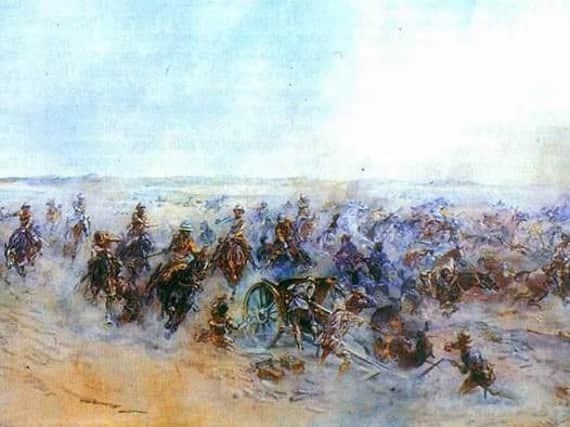The story of Warwickshire soldiers who were in the last British cavalry charge - 100 years on


The Charge at Huj in Palestine on November 8, 1917, carried out by soldiers of the Warwickshire Yeomanry and Worcestershire Yeomanry, helped fellow troops who were pinned down by Turkish and German gunners.
The battle was part of the Britain’s long war in Palestine against the Ottoman Empire during the First World War.
Advertisement
Hide AdAdvertisement
Hide AdBy November 1917, the Turks, allies of Germany, had been beaten at Gaza and were withdrawing toward Jerusalem.


But as the 60th (London) Division advanced on the small town of Huj, they found the way blocked by a mixed force of Turkish and German gunners. Unable to move, the Londoners called for the cavalry.
The scene was set for the last classic cavalry charge in the history of the British Army.
On a dusty ridge in the Holy Land, outnumbered 10 to one, the riders faced the blazing muzzles of field guns.
Advertisement
Hide AdAdvertisement
Hide AdIt was a scene which had hardly changed since the Charge of the Light Brigade 63 years earlier. Even the distance of half a league (1.5 miles) was the same.


The difference was that this charge was carried out not by the best of the regular cavalry but by a couple of Yeomanry units from the West Midlands.
They were ploughboys and factory hands who learned their skills on drill nights and weekends around Warwick, Leamington, Stratford, Dudley and Stourbridge as part of the Territorial Force (later the Territorial Army).
At the word of command, this force of 12 officers and 158 men drew their swords and galloped against the guns and a mass of 2,000 Turkish soldiers.
Advertisement
Hide AdAdvertisement
Hide AdDarcy Harold Jones, the last survivor of the charge who died in 1997, recalled an officer shouting: “It’s the guns we’re after, lads!”
But the Turks, with German and Austrian advisers, stood their ground, firing shells at point-blank range. One group of the Worcestershire Yeomanry rode straight at the main Turkish infantry force.
The rest, joined by the Warwickshire Yeomanry and spurred on by their officers’ hunting horns, thundered into the artillery lines, scattering the gunners.Author Colin Smith researched the charge for the climax in his 1991 novel, The Last Crusade. He interviewed some of the last survivors to create this dramatic image.
Weidinger, a German staff officer, witnessed the charge. He said: “They were not coming in the way Weidinger had always imagined a cavalry charge, a great glorious mass of men and horseflesh advancing on the enemy stirrup to stirrup. They looked more like Cossacks than regular cavalry.”
Advertisement
Hide AdAdvertisement
Hide AdOne eye-witness recalled: “Serving their guns rapidly, the artillerymen constantly shortened the range, until, as the shouting Yeomanry dashed sword in hand up to the batteries, shells were bursting and scattering widely as they left the muzzles.
“While they were ploughed by the shells, the horsemen also rode through a whirl of machine-gun fire. But they spurred right home, sabred the gunners as they served their pieces, and then dashed at a nest of machine-guns and killed the crews.”
The only officer of the Worcestershire Yeomanry to escape uninjured, Lieutenant Mercer, described the charge. He said: “Machine guns and rifles opened up on us the moment we topped the rise behind which we had formed up. I remember thinking that the sound of crackling bullets was just like hailstorm on a iron-roofed building, so you may guess what the fusillade was.
“A whole heap of men and horses went down twenty or thirty yards from the muzzles of the guns. The squadron broke into a few scattered horsemen at the guns and seemed to melt away completely.
Advertisement
Hide AdAdvertisement
Hide Ad“For a time I, at any rate, had the impression that I was the only man left alive. I was amazed to discover we were the victors.”
Major Oscar Teichman, the medical officer for the Worcestershire Yeomanry writing in the Cavalry Journal in 1936, said: “The Charge at Huj had it occurred in a minor war would have gone down to history like the Charge of the Light Brigade at Balaclava.
“In the Great War when gallant deeds were being enacted on all fronts almost daily it was merely an episode, but as the official historian remarks, for sheer bravery, the episode remains unmatched.”
It was all over in 20 minutes. Twenty-six yeomen died in the charge and 40 were wounded. One hundred horses perished, some killed by shells which passed straight through them before exploding. But the attack still succeeded.
Advertisement
Hide AdAdvertisement
Hide AdAnd even in the blood-lust, mercy was shown. Seventy prisoners were taken, together with eleven guns, one of which has pride of place in the Warwickshire Yeomanry Museum in Warwick.
The Warwickshire and Worcestershire Yeomanry were attached to an Australian force whose official history recorded: “This charge had taken place in full view of the Australians who were quick to appreciate the fact that the British Territorial horsemen could no longer be estimated lightly as campaigners.”
The Charge at Huj was not the last cavalry action of the war. Some Australian cavalry later charged, brandishing bayonets. Some British riders harassed the Germans in France right up to the Armistice on November 11, 1918.
But Huj was the last occasion when British cavalrymen, without any supporting fire, charged enemy guns and took them at swordpoint.
Advertisement
Hide AdAdvertisement
Hide AdIt was a decisive moment in the liberation of Palestine and the creation, 30 years later, of the state of Israel.
Peter Rhodes served as a Territorial Army officer with 67 (The Queen’s Own Warwickshire & Worcestershire Yeomanry) Signal Squadron, a successor unit to the regiments that fought at Huj.